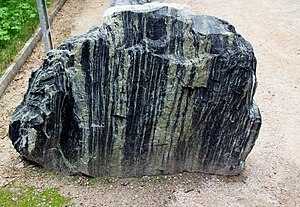| Metamorphic rock | |
 An amphibolite boulder in the Botanical Gardens of Charles University, Prague, Czech Republic. | |
| Composition | |
|---|---|
| Amphiboles, such as hornblende and actinolite, often with plagioclase. | |
| Physical Characteristics | |
| Fabric | Schistose |
| Relationships | |
| Protoliths | Mafics, such as basalt |


Amphibolite (/æmˈfɪbəlaɪt/) is a metamorphic rock that contains amphibole, especially hornblende and actinolite, as well as plagioclase feldspar, but with little or no quartz. It is typically dark-colored and dense, with a weakly foliated or schistose (flaky) structure. The small flakes of black and white in the rock often give it a salt-and-pepper appearance.
Amphibolite frequently forms by metamorphism of mafic igneous rocks, such as basalt. However, because metamorphism creates minerals entirely based upon the chemistry of the protolith, certain 'dirty marls' and volcanic sediments may also metamorphose to an amphibolite assemblage. Deposits containing dolomite and siderite also readily yield amphibolite (tremolite-schist, grunerite-schist, and others) especially where there has been a certain amount of contact metamorphism by adjacent granitic masses. Metamorphosed basalt (metabasalt) creates ortho-amphibolite and other chemically appropriate lithologies create para-amphibolite.
Although tremolite is a metamorphic amphibole, it is most commonly derived from highly metamorphosed ultramafic rocks, and thus tremolite-talc schist is not generally considered a variety of amphibolite. A holocrystalline plutonic igneous rock composed primarily of hornblende amphibole is called a hornblendite, which is usually a crystal cumulate rock. Igneous rocks with greater than 90% amphiboles, which have a feldspar groundmass, may be lamprophyres.